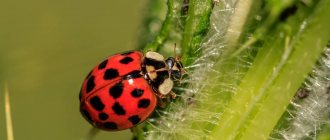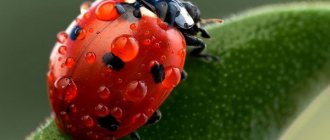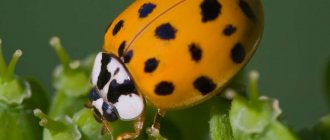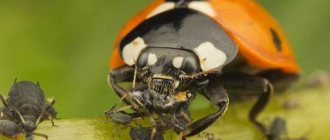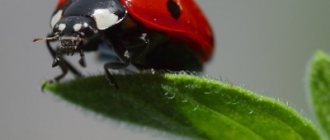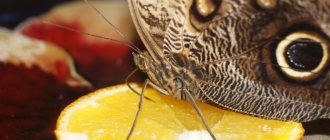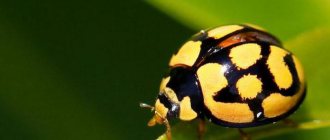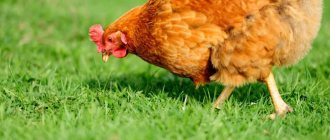Beetles, like other insects, can be harmful or beneficial. The first ones strive to reduce our harvest, destroy flowers and harm trees. The latter are trying their best to help us and exterminate dangerous relatives.
We have written about insect pests more than once. Now it’s the turn to recognize our defenders by sight.
- All garden pests in tables with descriptions, photos and control measures
We have compiled a “dossier” for you on each pest - save this collection!
- All garden pests - photos, names, descriptions and control measures
We have collected for you dossiers on 60 or more garden “villains”.
Ladybug (Coccinellidae)
The bright red (there are also yellow-colored species) beetle with black dots has been known to everyone since childhood. However, not everyone knows that the ladybug is not only beautiful, but also a very useful insect. If she has settled on your site, you can rejoice: you have a reliable assistant in the fight against pests.
Most species of ladybirds are predators, not only adults, but also larvae. Their diet consists of insects, which cause great harm to the garden. Food for helper beetles are aphids, scale insects, scale insects, leaf beetles, spider mites and other small pests. Thanks to their incredible gluttony, ladybugs help regulate the number of pests. So, one larva can eat up to 70 aphids per day, an adult - even more, about 100 pieces.
Ladybug larva
The coloring of ladybug larvae often indicates what they feed on. Thus, older larvae (in total, ladybird larvae go through 4 stages), which feed on aphids, are quite brightly colored. There is even such a pattern: the more active the larva is, the stronger the brightness appears. The dark color of the larvae's integument most often indicates that it feeds on false scale insects. With age, the color may change.
With the onset of cold weather, ladybugs gather in one place: under the bark of trees, fallen leaves or in another shelter. Due to the large concentration of beetles, the temperature in the shelter is higher than outside, which helps the ladybugs survive the winter. The lifespan of insects depends on the availability of food and lasts from several months to one or two years.
Bees
This insect is simply basking in its glory. Everyone knows that beneficial insects, bees, are human helpers. They not only actively participate in the pollination process, but also provide many useful products: honey, wax, propolis and much more.
Many people combine gardening and beekeeping. The hives can be installed directly in the garden or nearby. Apple, pear, plum, gooseberry and some other garden crops would not be able to bear fruit without the help of bees.
It is difficult to overestimate the merits of this insect. They do most of the work of pollinating plants.
In addition to domestic bees, there are also wild breeds of bees. They settle in shady forests and plantings and also sometimes fly into gardens in search of nectar. It is difficult to domesticate them, and there is no point in it - it is easier to breed domestic ones.
Stethorus
Stetorus is the closest “relative” of the ladybug: both beetles belong to the same family. However, in appearance they bear little resemblance.
Stetorus is a small bug (its maximum length is only 1.6 mm) and black. However, despite its tiny size, it copes with the destruction of pests “excellently”. Stetorus uses spider mites as food. During its existence, the bug eats at least 2000 ticks. For this reason, Stetorus is also called the tick ladybird.
Stetorus larva. Photo from scontent.ces.ncsu.edu
Before using chemicals to control spider mites, carefully inspect the plant. Perhaps tiny stetorus beetles are already operating there and they will cope with ticks without any “chemistry”.
Appearance
This is a bug 5-7 mm long, in appearance resembling an ordinary ladybug , with one difference - there are as many as 28 points on the wings.
The color itself is also not so bright - brown-red or red. An interesting feature is a light whitish coating , which is actually tiny hairs.
Photo of epilyachna and its larvae:
Ground beetle (Carabidae)
Ground beetles are one of the most numerous families of beetles on the planet. According to some reports, the number of species of this insect reaches 50 thousand; more than 3 thousand species live in Russia. The forest ground beetle (its other name is the garden ground beetle) is found most often in summer cottages.
Due to the wide variety of species, it is difficult to unambiguously describe the appearance of the beetle. Most often, ground beetles are dark in color; in some species, the elytra have a metallic sheen. The sizes also vary greatly: there are very tiny individuals, whose length is slightly more than 1 mm, and there are 10-centimeter giants. On average, the body length of ground beetles that live in the middle zone reaches 2-4 cm.
Despite the presence of wings, most species of ground beetles fly very poorly, and some lack this ability altogether. These beetles move with the help of their thin and rather long legs, and they do it very quickly.
Ground beetle larva
Only some species of ground beetles are phytophagous, i.e. eat plant foods. The bulk of insects are predators, both adult beetles and larvae. Due to this feature, ground beetles are used as biological protection agents for crops against pests.
Ground beetles happily eat caterpillars, slugs, snails, aphids, sawflies, as well as eggs, pupae and larvae of various insect pests. In a word, the ground beetle is one of the main assistants of the summer resident. She stands day and night (some species are more active during the day, while others are nocturnal) to protect your crop.
Reviews
The problem of small brown bugs appearing in an apartment is often discussed on forums. Users share their experience of exterminating them and leave reviews of effective means.
Svetlana Lebedeva: “I constantly found corpses and barely alive bugs on the windowsill. I noticed that they were crawling out of the cracks in the wooden frames. I took them and covered them with hot glue for creativity. I haven’t watched it since then.”
Ksenia: “For several weeks I struggled with beetles on the windowsill. Every day I poisoned them with dichlorvos, wiped them down, and threw out the corpses. And then I finally got around to going to the hardware store and showing the dead bugs to the seller. There they were identified as soil midges that live in the ground in flower pots. The larvae eat the roots. And I kept wondering what was wrong with my plants, why the leaves were turning yellow and curling. In general, they sold me an ampoule of the drug “Aktara”. It is safe for plants, and bugs and larvae die. I diluted it in 10 liters of water and watered all the plants until water appeared in the trays. No more pests appeared. The window sill is clean, the flowers have recovered, it’s happiness for me to get rid of these nasty insects.”
Alexander: “I came across bugs on the windowsill a couple of years ago. I still don’t understand what they eat. Everything is intact, carpets, furniture, and cereals. I didn't find any nests anywhere. Harmless, but nasty. Appear in spring. I treat the window sill and frame with Mashenka. They seem to disappear, and then “hello” again.
Tatyana: “If the bugs are very tiny, round and hard, then they are definitely skin beetles. In our country they divorced somehow completely unnoticed. They tried everything they could to get it out. We are already suffocating from dichlorvos, and there are only more of them. In the end they couldn’t stand it and called the pest control service. More than a month has passed, there are no insects in the house, not even mosquitoes and spiders.”
Jumping beetles (Cicindelinae)
Ground beetles, like ladybugs, also have “relatives” in the insect world. These are jumping beetles. They deservedly received this name: horses are considered the fastest animals on earth. With a body length of 1-2 cm, they manage to cover a distance of 2 or more meters with their thin legs in one second!
In addition to long thin legs, the jumping beetle can be recognized by its large bulging eyes and dark elytra with light spots. For this design, the horses received their English name - “tiger beetle” (tiger beetle).
Larva of a jumping beetle. Photo from marsetblog.livejournal.com
However, they were not included on our list for their ability to move quickly or for their excellent vision. Jumping beetles and their larvae are predators that eat crop pests. Ants, mole crickets and mosquitoes get the most damage from horses. Over the summer, one horse (and both the adult and the larva are very voracious) can destroy more than 400 harmful insects. By reducing their numbers, jumping beetles thereby help protect crops without the use of harmful insecticides.
Control measures
- Areas for planting vegetables must be clean, without heaps of dry debris, weeds or any other plant cover.
- Plant different types of nightshades away from each other. The female epilyachna spreads her egg clutches over many plants; plantings spaced apart from each other will prevent the cow from spreading over a large area of the garden.
- Ruthless weed control. The pest also leaves egg clutches on them.
- Treatment of plants using the high hilling method. Insects buried under a layer of soil die.
- Spraying with chemicals. Carry out during the period of larval growth, in early summer. But it cannot be used during the ripening period of fruits, since they also absorb toxic substances.
Thus, simply maintaining your plot in exemplary order, avoiding weed thickets and following the recommendations of agronomists on the correct planting of vegetables will help to significantly reduce the risk of invasion of an even cute, but very harmful insect.
Pied beetle (Thanasimus formicarius)
Another useful beetle is the ant beetle (other names are ant beetle and bark beetle). Among pied beetles, not all species are beneficial. For example, the bee moth (common bee beetle) is a pest beetle, because destroys bee larvae and pupae, and sometimes adult insects.
The ant moth, unlike its brother, is a welcome guest in any garden and forest. It hunts for bark beetles, eating adults, pupae, larvae, and eggs. If on the path of an ant beetle there are tar beetles, borers, longhorned beetles or horntails, then it destroys these tree pests as well.
Pied beetle larva
It is not difficult to recognize the Pied Beetle: its red and black elytra with two white bands immediately catch the eye. The size of the insect ranges from 5 to 10 mm. But it is unlikely that you will be able to see the pinkish ant beetle larva, because... it hides and exterminates pests (larvae are also predators) under the bark of trees.
bumblebees
Many people mistake them for slackers, but bumblebees are actually very beneficial insects in the garden. They are well adapted to the harsh northern living conditions, so they work even where other pollinators are not found.
With long proboscis they extract nectar even from plants with narrow corollas, inaccessible to other insects.
When collecting nectar, bumblebees transfer pollen, and they do it very quickly. Entomologists have calculated that the field bumblebee visits more than 2.5 thousand plants in one flight.
Fire beetle (Cantharidae)
Another red-and-black helper at the dacha is the firefighter beetle from the Myagkotelki family (these beetles are often called soft-bodied beetles).
Adults are diurnal. They can be seen on plants, where they sit and wait for prey. Firefighter beetles happily eat flies, small caterpillars, aphids, scale insects, and destroy insect eggs. If it happens that the number of beetles exceeds the amount of food, firefighters can change the diet and switch to plant food - buds and ovaries. However, this happens extremely rarely.
Fire beetle larva
Soft-bodied larvae, like adults, are also predators. However, they lead a more secretive lifestyle: they live in fallen leaves, the top layer of soil, under the bark of trees, under stones. Fire beetle larvae feed on worms, slugs, centipedes, larvae and eggs of other insects.
Developmental stages and lifestyle
The potato ladybug reproduces once during the summer season - May-June.
Epilyachna reproduces quickly, if not rapidly. The female lays eggs in groups of 10-20 pieces. on the inner surface of a leaf or among fallen leaves. In total, her litter is 250-500 eggs! The eggs are small, 1 mm, faded yellow in color. Within a week after laying, larvae emerge from them, which take 3 weeks to pupate and go into suspended animation for 9 days. After this, a mature individual appears.
The cow larva is quite unusual in appearance. This is a greenish-yellowish caterpillar, completely covered with black bristles. The fibers are soft and not poisonous, as is usually the case. Rather, they perform a motor function so that the larva can crawl.
The insect is constantly on the move. It wanders from plant to plant, and as winter approaches, it looks for a secluded place to survive the cold. This could be dry leaves, unkempt piles of weeds, or just a hole in the soil. In the spring, epilyachna emerges from the shelter and begins the breeding stage. At the end of August, the pest leaves the potato fields and again looks for a place to winter.
Lacewing
Another insect that gardeners often get is the lacewing. “A pest or a protector in front of me?” - the man thinks and, just in case, drives away, or even destroys the poor thing.
But an experienced gardener knows that this light green insect, similar to a dragonfly, is one of the most important enemies of aphids. But this beauty does not harm the garden, does not eat fruits, does not sharpen wood, and does not feed on “work colleagues.” Why is she offended? Most likely, this comes from simple ignorance. And the appearance of the larva has an effect - to those who are afraid of insects, they all seem the same. In fact, it is the larval form that eats most of the aphids. Adult insects often feed not on the pests themselves, but on the sweetish substance they secrete.
Who is this lacewing? Pest? Or is it still a defender? Rest assured, this insect will only benefit your garden by eliminating enemy aphid colonies.
Aphids are the favorite “friend” of ants
Aphids are very prolific, and a few days are enough for them to spread throughout all the beds.
At the same time, the insect does not neglect any plant: cucumbers, tomatoes, pumpkins and even weeds - everything is used. The danger is that aphids suck the juice from the leaves and at the same time poison the plants with poison, which causes their disease and death. If you leave the pest on the plantings, you can forget about a good harvest
In addition, aphids attract ants with their honeydew, which will take care of them and feed them on the best plants.
If you leave the pest on the plantings, you can forget about a good harvest. In addition, aphids attract ants with their honeydew, which will take care of them and feed them on the best plants.
The good news is that aphids are afraid of numerous folk remedies and, with regular treatment, will leave the beds alone. Infusions and solutions made from soap, zest, ash, hot pepper, and onion will repel insects and save your vegetables.
How to fight aphids - effective folk remedies Aphids are one of the most dangerous garden pests. Find out how to get rid of this insect using traditional methods.

